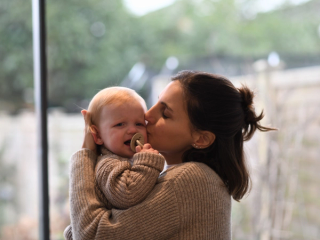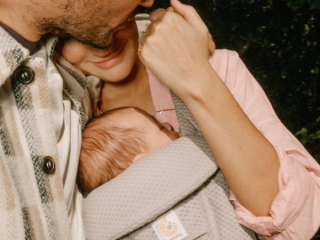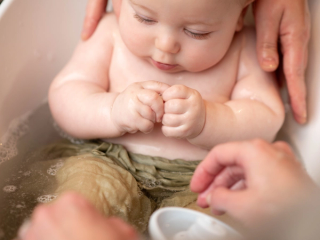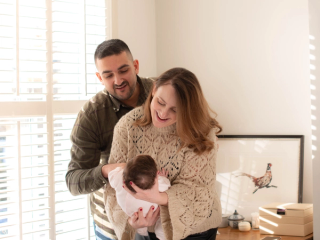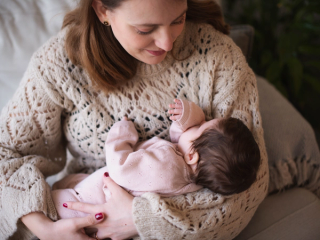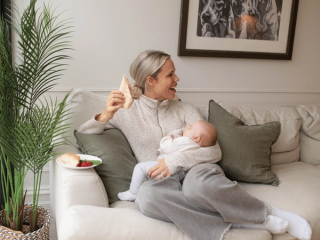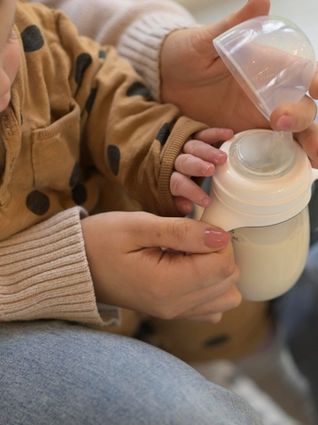
- Home
- Advice Hub
- Newborn
- New Parent Support
- Mum Thumb - What Is It & How Do You Treat It?
Mum thumb - What is it & how do you treat it?
Our Pelvic Health Physiotherapist Aby shares what it is, why mums get it and what you can do about it.
Have you got pain in your thumb and wrist? You might have mum thumb!
What is it?
It’s the pain that Mum’s commonly get at the base of the thumb. The medical term for Mum Thumb is ‘De Quervains Syndrome’ and it occurs when the sheath covering the tendons on the thumb side of the wrist becomes thickened and painful. If the sheath is thicker then there’s less room for the tendons to slide freely as you move your thumb and wrist, which can also make the tendons sensitive.
Why do you get it as a Mum?
Essentially because life with a baby is repetitive. You have to do the same tasks over and over again. How many times in a day do you lift them up, carry them around, make up a bottle (if you’re formula feeding1), open the food jar, close the food jar, stroke their face whilst they go to sleep? It’s very taxing on the hand and wrist. It comes down to load versus capacity, and this principle applies throughout the body not just at your thumb. If the strength in your hand and wrist is lower than the capacity it is having to work at for a prolonged period then you will start to get a repetitive strain injury.
How do I know if I have it?
The key symptom is pain at the base of the affected thumb, although some may identify it more as wrist pain. You will find certain thumb movements initiate the pain, and if you were to continue doing it then it would gradually worsen. Movements to look out for are lifting the thumb up, like when using scissors or widening your hands to pick up your baby, unscrewing jar lids, even texting can be quite painful. If you press along the back of your thumb down towards your wrist, often the area over your wrist joint will be painful to press on. Some also get swelling if the area has become inflamed.
If you have any other symptoms, the pain is severe and persisting, then please go to your GP to rule out other conditions and ensure you have the right treatment plan.
What can I do about it?
If you were to Google ‘De Quervain’s Syndrome’ then usually the first suggestion is activity modification. Whilst this is correct it’s also a bit laughable/infuriating for a Mum. “You want me to not pick up by baby?” I can hear from my desk as I type this – so I apologise for even raising it. However, where you can reduce the activities that aggravate, do. Can you get someone else to open the food jars, try and mix up which hand you are using and not always go to your dominant side? But hey, it’s pretty tricky as a Mum, so just know that as your baby grows and gets slightly more self-sufficient, the condition often improves.
In the mean time, keep on top of your pain. You can use paracetamol and ibuprofen to manage, just make sure you check the packet and never go over the recommended dosage. Some Mums find wearing a thumb splint helpful, although there’s no solid research to back this up. You want to wear it for short periods where you are going to be doing things that aggravate the thumb, like when you’re at home on your own. Then take it off when the baby is asleep, in the evening and over night to prevent your thumb getting weak and stiff.
For lots of people mum thumb settles on its own after a few weeks. However, some people need more assistance, and a referral for Physiotherapy/Physical Therapy is required. You can do this through your GP or self fund if you have the means. The treatment is focused on improving that load versus capacity I mentioned earlier. Essentially we build a resistance training programme for your hand and wrist; if we increase the strength, you will have a larger capacity to do all the tasks you need to do. This is a fine balance though when you are in pain. We usually have to reduce pain levels first, then get the wrist and hand stronger, otherwise we aggravate the issue further. If Physiotherapy management can’t get the pain under control then the next stop is a steroid injection to the base of the thumb. This settles the pain and inflammation giving a window of opportunity to do the strengthening exercises to increase your capacity.
Like with lots of postnatal conditions it’s easy to suffer in silence as you just try and keep all the juggling balls of motherhood in the air, but there’s lots that can be done, so get support.
Advice & tips

Want to read more? Join the HiPP BabyClub for full access to this article.
As a BabyClub member, you'll get access to a range of exclusive benefits, including:
Monthly competitions
Discounts from our Partners
Expert advice tailored to your little one's age
Weaning recipes
HiPP shop discounts*
*10% off HiPP's online shop does not apply to our First Infant, Anti-Reflux or Comfort Formula Milk.
Important notice: Breastfeeding is best. Follow on milk should only be used as part of a mixed diet from 6 months. Talk to a healthcare professional.





